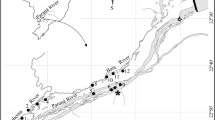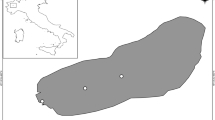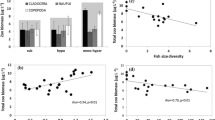Abstract
Large zooplankton can efficiently graze on algae and thereby improve water quality. However, zooplankton body size is considered to decrease with decreasing latitude because of the high fish predation and warm temperatures at lower latitudes. To explore how fish stocking has destabilized the trophic cascade and influenced water quality along a latitudinal gradient of reservoirs, we compared zooplankton body size and trophic cascades to water quality indicators in the subtropical Lake Qiandaohu and in tropical Guangdong reservoirs. The results showed that the body length and total biomass of the dominant zooplankton in Lake Qiandaohu were much larger than those of zooplankton in the Guangdong reservoirs. Moreover, fish predation was the key factor influencing the changes in zooplankton body size and total biomass in Lake Qiandaohu. In the Guangdong reservoirs, water temperature and total phosphorus were the pivotal drivers of zooplankton body size and biomass, respectively. In addition, structural equation models showed that the decreasing zooplankton body size and biomass under fish pressure weakened the grazing pressure on phytoplankton and indirectly contributed to the low water clarity in Lake Qiandaohu. However, fish had little influence on the inefficient algal grazing of zooplankton in the Guangdong reservoirs. Overall, zooplankton can function as an indicator of water quality in fish-controlled subtropical reservoirs but not in nutrient-controlled tropical reservoirs.






Similar content being viewed by others
Data Availability
Data used in this study have been made available at https://doi.org/10.5061/dryad.1ns1rn8tb.
References
Bayne D, Maceina M, Reeves W. 1994. Zooplankton, Fish and Sport Fishing Quality Among Four Alabama and Georgia Reservoirs of Varying Trophic Status. Lake Reservoir Manage 8(2):153–163.
Behrens M, Lafferty K. 2007. Temperature and diet effects on omnivorous fish performance: implications for the latitudinal diversity gradient in herbivorous fishes. Can J Fish Aquat Sci 64(6):867–873.
Brooks JL, Dodson SL. 1965. Predation body size and composition of plankton. Science 150(3692):28–35.
Brucet S, Boix D, Quintana XD, Jensen E, Nathansen LW, Trochine C, Meerhoff M, Gascon S, Jeppesen E. 2010. Factors influencing zooplankton size structure at contrasting temperatures in coastal shallow lakes: Implications for effects of climate change. Limnol Oceanogr 55(4):1697–1711.
Chara-Serna A, Maxson K, Anderson A, Alison M, Zalay B, Casper A, 2019. Zooplankton as an indicator of the ecosystem response to bigheaded carp suppression via commercial harvest in the illinois river (2010–2017). INHS Technical Report 2018 (37).
Chiang SC, Du NS. 1979. Fauna Sinica Crustacea: freshwater Cladocera. Beijing: Science Press Academia Sinica (in Chinese).
Daufresne M, Lengfellner K, Sommer U. 2009. Global warming benefits the small in aquatic ecosystems. Proc. Natl. Acad. Sci. u. s. a. 106:12788–12793.
Deng X, Chen J, Hansson LA, Zhao X, Xie P, 2020. Eco-chemical mechanisms govern phytoplankton emissions of dimethylsulfide in global surface waters. Natl Sci Rev, nwaa140, https://doi.org/10.1093/nsr/nwaa140
Geng H, Xie P, Deng D, Zhou Q. 2005. The rotifer assemblage in a shallow eutrophic Chinese lake and its relationships with cyanobacterial blooms and crustacean zooplankton. J Freshw Ecol 20:93–100.
Gillooly JF, Dodson SI. 2000. Latitudinal patterns in the size distribution and seasonal dynamics of new world, freshwater cladocerans. Limnol Oceanogr 45(1):22–30.
Gliwicz ZM. 1986. Predation and the evolution of vertical migration in zooplankton. Nature 320(6064):746–748.
González-Bergonzoni I, Meerhoff M, Davidson T, Mello F, Baattrup-Pedersen A, Jeppeson E, and others 2012. Meta-analysis Shows a Consistent and Strong Latitudinal Pattern in Fish Omnivory Across Ecosystems. Ecosystems 15(3):492–503.
Green BW, Smitherman RO. 1984. Relative growth, survival and harvestability of bighead carp, silver carp, and their reciprocal hybrids. Aquaculture 37(1):87–95.
Gyllström M, Hansson L, Jeppeson E, García-Criado F, Gross E, Irvine K, and others 2005. The role of climate in shaping zooplankton communities of shallow lakes. Limnol Oceanogr 50(6):2008–2021.
He H, Jin H, Jeppesen E, Li K, Liu Z, Zhang Y. 2018. Fish-mediated plankton responses to increased temperature in subtropical aquatic mesocosm ecosystems: Implications for lake management. Water Res 144:304–311.
Huang X, Chen W, Cai Q, 1999. Survey, observation and analysis of lake ecology. Standard methods for observation and analysis in Chinese Ecosystem Research Network, Series V. Standards Press of China, Beijing. (in Chinese)
Jeppesen E, Jensen J, Søndergaard M, Lauridsen T, Landkildehus F. 2000. Trophic structure, species richness and biodiversity in Danish lakes: changes along a phosphorus gradient. Freshwater Biol 45(2):201–218.
Jeppesen E, Søndergaard M, Lauridsen T, Davidson T, Liu Z, Mazzeo N, and others 2012. Biomanipulation as a restoration tool to combat eutrophication: recent advances and future challenges. Adv Ecol Res 47:411–487.
Kalff J, 2002. Limnology: Inland water ecosystems. Prentice Hall.
Koste W, 1978. Rotatoria: die radertiere mitteleuropas. Gebruder Borntraeger.
Kratina P, Greig H, Thompson P, Carvalho-Pereira T, Shurin J. 2012. Warming modifies trophic cascades and eutrophication in experimental freshwater communities. Ecology 93:1421–1430.
Lazzaro X. 1997. Do the trophic cascade hypothesis and classical biomanipulation approaches apply to tropical lakes and reservoirs? Verh Intemat Verein Limnol 26:719–730.
Lemmens P, Declerck SAJ, Tuytens K, Vanderstukken M, De Meester L. 2017. Bottom-up effects on biomass versus top-down effects on identity: A multiple-lake fish community manipulation experiment. Ecosystems 21(1):166–177.
Lewis MW. 1987. Tropical limnology. Annu Rev Ecol Syst 18(1):159–184.
Li Y, Xie P, Zhang J, Tao M, Deng X. 2017. Effects of filter-feeding planktivorous fish and cyanobacteria on structuring the zooplankton community in the eastern plain lakes of China. Ecol Eng 99:238–245.
Lin Q, Jiang X, Han B, Jeppesen E. 2014. Does stocking of filter-feeding fish for production have a cascading effect on zooplankton and ecological state? A study of fourteen (sub)tropical Chinese reservoirs with contrasting nutrient concentrations. Hydrobiologia 736(1):115–125.
Liu Q, Chen Y, Li J, Chen L. 2007. The food web structure and ecosystem properties of a filter-feeding carps dominated deep reservoir ecosystem. Ecol Model 203(3–4):279–289.
Liu Z, Hu J, Zhong P, Zhang X, Ning J, Larsen SE, and others 2018. Successful restoration of a tropical shallow eutrophic lake: Strong bottom-up but weak top-down effects recorded. Water Res 146:88–97.
Mao Z, Gu X, Cao Y, Zhang M, Zeng Q, Chen H and others, 2020. The role of top-down and bottom-up control for phytoplankton in a subtropical shallow eutrophic lake: Evidence based on long-term monitoring and modeling. Ecosystems.
Meerhoff M, Mello T, Kruk C, Alonso C, González-Bergonzoni I, Pacheco J, and others 2012. Environmental Warming in Shallow Lakes: A Review of Potential Changes in Community Structure as Evidenced from Space-for-Time Substitution Approaches. Adv Ecol Res 46(46):259–349.
Pace L, Orcutt J. 1981. The relative importance of protozoans, rotifers, and crustaceans in a freshwater zooplankton community. Limnol Oceanogr 26(5):822–830.
Pace M, Carpenter S, Johnson R, Kurtzweil J. 2013. Zooplankton provide early warnings of a regime shift in a whole lake manipulation. Limnol Oceanogr 58(2):525–532.
Peter K, Sommer U. 2012. Phytoplankton cell size: Intra-and Interspecific effects of warming and grazing. PloS One 7(11):e49632.
Rosseel Y. 2012. Lavaan: an R package for structural equation modeling. J. Stat. Softw. 48:1–36.
Sanful P, Aikins S, Hecky R. 2017. Depth distribution of zooplankton in relation to limnological gradients under different stratification and interannual regimes in a deep, tropical crater lake. Ann Limnol-Int J Lim 53:293–307.
Schermelleh-Engel K , Moosbrugger H , H Müller. Evaluating the Fit of Structural Equation Models: Tests of Significance and Descriptive Goodness-of-Fit Measures[J]. Mpr Online, 2003, 8(8):23–74.
Shen J, Tai C, Zhang Z, Li D, Song and Chen G, . 1979. Fauna sinica crustacea freshwater copepoda. Institute of Zoology Academia Sinica Beijing: Science Press of China Beijing (in Chinese).
Shi W, 2010. An Analysis of the Spatial and Temporal Variation of Zooplankton Community Structure and the Correlation with Influencing Factors in Qiandao Lake. Master's thesis. Shanghai Ocean University. (in Chinese)
Søndergaard M, Liboriussen L, Jeppesen E. 2008. Lake restoration by fish removal: short- and long-term effects in 36 danish lakes. Ecosystems 11(8):1291–1305.
Velthuis M, Lisette N, Frenken T, Stephan S, Kazanjian G, Aben R and others, 2017. Warming advances top-down control and reduces producer biomass in a freshwater plankton community. Ecosphere 8(1), e0165.1.
Walsh C, Mac Nally R, 2013. hier.part: hierarchical partitioning. R package version 1.0–4. R Project for Statistical Computing, Vienna.
Walther G, Post E, Convey P, Menzel A, Parmesan C, Beebee T, and others 2002. Ecological responses to recent climate change. Nature 416(6879):389–395.
Wang L, Shen H, Wu Z, Yu Z, Li Y, Su H, and others 2020. Warming affects crustacean grazing pressure on phytoplankton by altering the vertical distribution in a stratified lake. Sci Total Environ 734:139195.
Wang J. 1961. Freshwater rotifer fauna in China. Beijing: Science Press (in Chinese).
Wu Z, Zhang Y, Zhou Y, Liu M, Shi K, Yu Z. 2015. Seasonal-spatial distribution and long-term variation of transparency in Xin’anjiang reservoir: implications for reservoir management. Int J Env Res Pub He 47(3):9492–9507.
Yu J, Chen J, Deng X, Wu Z, Yu Z, Xu J, and others 2019. Trophic patterns of bighead carp and silver carp follow the seasonality of resource availability. Water 11(7):1429.
Zhang JM, He ZH. 1991. Handbook for the investigation on the natural fisheries resources of inland waters. Beijing: The Agricultural Press. pp 12–169.
Acknowledgements
We thank the editor and anonymous reviewers for providing valuable comments on the manuscript and Chun’an County Fishery Administration and Port Administration for data on fish catches, as well as Hangzhou Bureau of Ecology and Environment, Chun’an Branch for data on environmental factors in Lake Qiandaohu. This work was jointly supported by the National Key Research and Development Program of China (2017YFA0605201), Hangzhou Municipal Ecology and Environment Bureau (0625-20216112), the State Key Laboratory of Freshwater Ecology and Biotechnology (2019FBZ03), and the Featured Institute Service Projects from the Institute of Hydrobiology, the Chinese Academy of Sciences (Y85Z061601).
Author information
Authors and Affiliations
Corresponding author
Ethics declarations
Conflict of interest
The authors declare that they have no conflict of interest.
Additional information
Author Contributions
LW conceived the study, ran the simulations and wrote the paper. LW, JY, JRL, GYD, YW and ZXW performed the experiment. JC, XFM and HJS ran additional simulations, produced the final figures and improved the text. HS contributed to initial simulations and discussions. PX contributed to discussions and improved the text.
Supplementary Information
Below is the link to the electronic supplementary material.
Rights and permissions
About this article
Cite this article
Wang, L., Chen, J., Su, H. et al. Is Zooplankton Body Size an Indicator of Water Quality in (Sub)tropical Reservoirs in China?. Ecosystems 25, 308–319 (2022). https://doi.org/10.1007/s10021-021-00656-2
Received:
Accepted:
Published:
Issue Date:
DOI: https://doi.org/10.1007/s10021-021-00656-2




